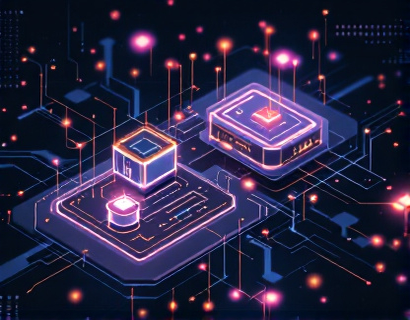Mastering Digital Currency Creation: A Guide to Cutting-Edge Software for Businesses and Blockchain Innovators
The rise of digital currencies has transformed the financial landscape, offering unprecedented opportunities for businesses and individuals alike. As blockchain technology continues to evolve, mastering digital currency creation has become essential for those looking to innovate and thrive in this dynamic environment. This comprehensive guide will explore the advanced software solutions available for creating digital currencies, focusing on customization, security, and scalability. Whether you are a novice or an expert, this guide will empower you to navigate the complexities of digital asset creation with confidence.
Understanding Digital Currency Creation
Digital currency creation involves the process of designing, launching, and managing digital tokens or currencies on a blockchain. This process can seem daunting, especially for those new to the technology. However, with the right tools and knowledge, anyone can successfully create their own digital currency. The key components of digital currency creation include blockchain technology, token standards, and the software used to facilitate the process.
Blockchain Technology
At the heart of digital currency creation is blockchain technology, a decentralized ledger that records transactions across multiple computers. This technology ensures transparency, security, and immutability, making it an ideal foundation for digital currencies. Understanding how blockchain works is crucial for anyone looking to create a digital currency, as it influences the design and functionality of the token.
Token Standards
Tokens can be created using various standards, with the most popular being ERC-20 and ERC-721 for Ethereum-based tokens. ERC-20 tokens are fungible, meaning each token is interchangeable with another, while ERC-721 tokens are non-fungible, representing unique assets. Choosing the right token standard is essential, as it determines how the token will function and interact with other tokens and smart contracts on the blockchain.
The Importance of Advanced Software
Creating a digital currency requires sophisticated software that simplifies the process and provides essential features. Advanced software solutions offer unparalleled customization, robust security, and seamless scalability, making them indispensable for businesses and innovators. Here are some key features to look for in digital currency creation software:
Customization
Every business has unique needs, and the ability to customize a digital currency is crucial. Advanced software allows users to tailor their tokens to meet specific requirements, such as defining the total supply, setting transaction fees, and implementing governance mechanisms. This level of customization ensures that the digital currency aligns with the business's goals and objectives.
Security
Security is paramount in the world of digital currencies. Advanced software solutions incorporate robust security measures to protect against hacks, fraud, and other threats. Features such as multi-signature wallets, encryption, and regular security audits are essential for safeguarding digital assets. By prioritizing security, businesses can build trust with their users and stakeholders.
Scalability
As a digital currency gains traction, it must be able to handle increased demand and transaction volume. Advanced software solutions are designed with scalability in mind, allowing businesses to grow without compromising performance. This includes features such as efficient consensus mechanisms and the ability to integrate with existing blockchain networks.
Streamlining the Digital Currency Creation Process
The process of launching and managing a digital currency can be complex, but advanced software streamlines this journey. Here are the key steps involved in digital currency creation:
1. Define the Purpose and Use Case
Before creating a digital currency, it is essential to define its purpose and use case. What problem does it solve? Who is the target audience? Understanding the goals of the digital currency will guide the design and functionality of the token.
2. Choose the Right Blockchain
Selecting the appropriate blockchain is a critical decision. Factors to consider include transaction speed, fees, and community support. Popular options include Ethereum, Binance Smart Chain, and Solana, each offering unique advantages and capabilities.
3. Design the Token
Once the blockchain is chosen, the next step is to design the token. This includes defining the tokenomics, such as total supply, distribution methods, and incentives for holders. A well-thought-out token design is crucial for attracting users and ensuring long-term success.
4. Develop Smart Contracts
Smart contracts are self-executing contracts with the terms of the agreement directly written into code. They automate processes and ensure that transactions occur as intended. Developing robust smart contracts is essential for the functionality and security of the digital currency.
5. Test the Token
Before launching the digital currency, thorough testing is necessary to identify and resolve any issues. This includes testing the smart contracts, transaction processes, and overall user experience. Rigorous testing helps ensure a smooth launch and builds confidence among users.
6. Launch the Digital Currency
After testing, the digital currency can be launched. This involves deploying the smart contracts on the chosen blockchain and making the token available for trading. A successful launch requires effective marketing and community engagement to attract users and investors.
7. Manage and Maintain the Currency
Once the digital currency is live, ongoing management and maintenance are essential. This includes monitoring transaction activity, addressing user feedback, and implementing updates as needed. A proactive approach to management helps ensure the long-term viability of the digital currency.
Empowering Businesses and Enthusiasts
Advanced software for digital currency creation empowers both businesses and enthusiasts to enter the blockchain space with confidence. By providing the necessary tools and resources, these solutions make it easier for anyone to design, launch, and manage their own digital currencies. This democratization of digital asset creation fosters innovation and encourages a diverse range of projects within the blockchain ecosystem.
For Businesses
Businesses can leverage digital currencies to enhance their operations, create new revenue streams, and engage with customers in innovative ways. Whether it's launching a loyalty program, facilitating transactions, or raising funds through an Initial Coin Offering (ICO), digital currencies offer a wealth of opportunities. Advanced software simplifies the process, allowing businesses to focus on their core objectives while navigating the complexities of blockchain technology.
For Enthusiasts
For individuals passionate about blockchain and digital currencies, advanced software provides the tools needed to bring their ideas to life. Whether creating a new token for a community project or experimenting with innovative use cases, enthusiasts can explore the possibilities of digital asset creation without the need for extensive technical knowledge. This accessibility encourages creativity and collaboration within the blockchain space.
Conclusion
Mastering digital currency creation is an essential skill for businesses and innovators looking to thrive in the evolving financial landscape. With advanced software solutions offering unparalleled customization, robust security, and seamless scalability, the process of launching and managing digital currencies has never been more accessible. By understanding the key components of digital currency creation and leveraging the right tools, anyone can confidently navigate the digital finance realm and contribute to the future of blockchain technology.










































